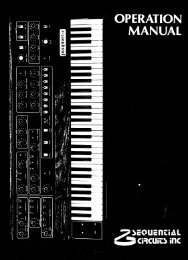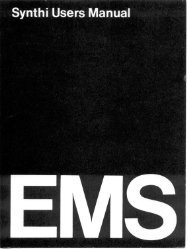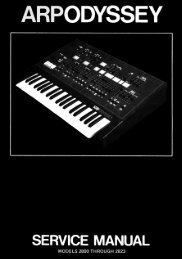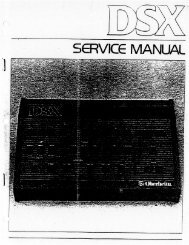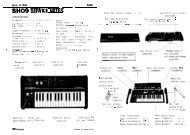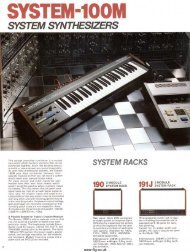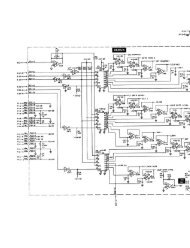ARP2600 - Fundamentals of Music Technology - Cyborgstudio.com
ARP2600 - Fundamentals of Music Technology - Cyborgstudio.com
ARP2600 - Fundamentals of Music Technology - Cyborgstudio.com
You also want an ePaper? Increase the reach of your titles
YUMPU automatically turns print PDFs into web optimized ePapers that Google loves.
020 - SECTION THREE: VCO-2<strong>of</strong> one waveform occurs at the lowest point <strong>of</strong> another. Thephase relationships <strong>of</strong> the other outputs can be easily summedup: outputs which are perpendicular to each other (i.e. abovebelow, or to one side) are 180 degrees out <strong>of</strong> phase. Thosediagonal to each other are in phase. Figure 3-5 illustrates thisrelationship. Red arrows represent out <strong>of</strong> phase relationshipswhile blue and green arrows represent in phase relationships.out <strong>of</strong>phaseTriangleout <strong>of</strong>phasein phaseSawtoothout <strong>of</strong>phasePULSE WAVESVCO-2 doesn’t really have a square wave output, but has apulse wave output instead. This is a very important featuresince a pulse wave is like a square wave, but is much moreflexible. Pulse waves, like a square wave, are partially “on”and partially “<strong>of</strong>f.” In terms <strong>of</strong> voltage, a pulse wave consists<strong>of</strong> ten volts for a moment, then zero volts for a moment. For a square wave, these two ‘moments’must be equal. In a pulse wave, they can be equal, but do not have to be equal. Thus, a square wave isreally just a kind <strong>of</strong> pulse wave.PULSE WIDTHOne important aspect <strong>of</strong> a pulse wave is that it is another parameter to change. That parameter is thepulse width. Of course, in Section 2, the reader learned that there are only two parameters <strong>of</strong> anoscillator one can change: frequency and timbre. One might think <strong>of</strong> pulse width as a sort <strong>of</strong>subheading under the ‘timbre’ parameter heading.Sineout <strong>of</strong>phasePulseFigure 3-5: The phaserelationships <strong>of</strong> VCO-2’s outputstime30% duty cycle50% duty cycletimeFigure 3-6: Pulse waves withdifferent duty cuclesPulse width is the name <strong>of</strong> the parameter that controls how much <strong>of</strong> thewave is ‘on’ and how much <strong>of</strong> the wave is ‘<strong>of</strong>f.’ Another name for pulsewidth is duty cycle. The duty cycle <strong>of</strong> a pulse wave is expressed as a percentage.The percentage tells how much <strong>of</strong> the duty cycle is ‘on.’ For instance,a pulse wave that has a pulse width <strong>of</strong> 20% would be a pulse wavewhich is ‘on’ 20% on the time, and ‘<strong>of</strong>f’ 80% <strong>of</strong> the time. Figure 3-6 illustratesa pulse width <strong>of</strong> 30%, and a pulse width <strong>of</strong> 50% (a square wave).Making changes in the pulse width changes the waveshape and thus thetimbre. This is why it is difficult to describe the pulse wave’s timbre: thetimbre changes significantly when the pulse width is changed. The timbrecan range from hollow when the duty cycle is near 50% to nasal when it isnearer 0% or 100%.On the 2600, changing VCO-2’s pulse width is simple. The pulse width ischanged by moving the PULSE WIDTH slider, right under the FINE TUNEslider. This control can be seen, along with VCO-2’s outputs and initialfrequency controls in Figure 3-7 on page 21. When the pulse width is set to50%, the VCO will produce a square wave (if it is properly calibrated).




